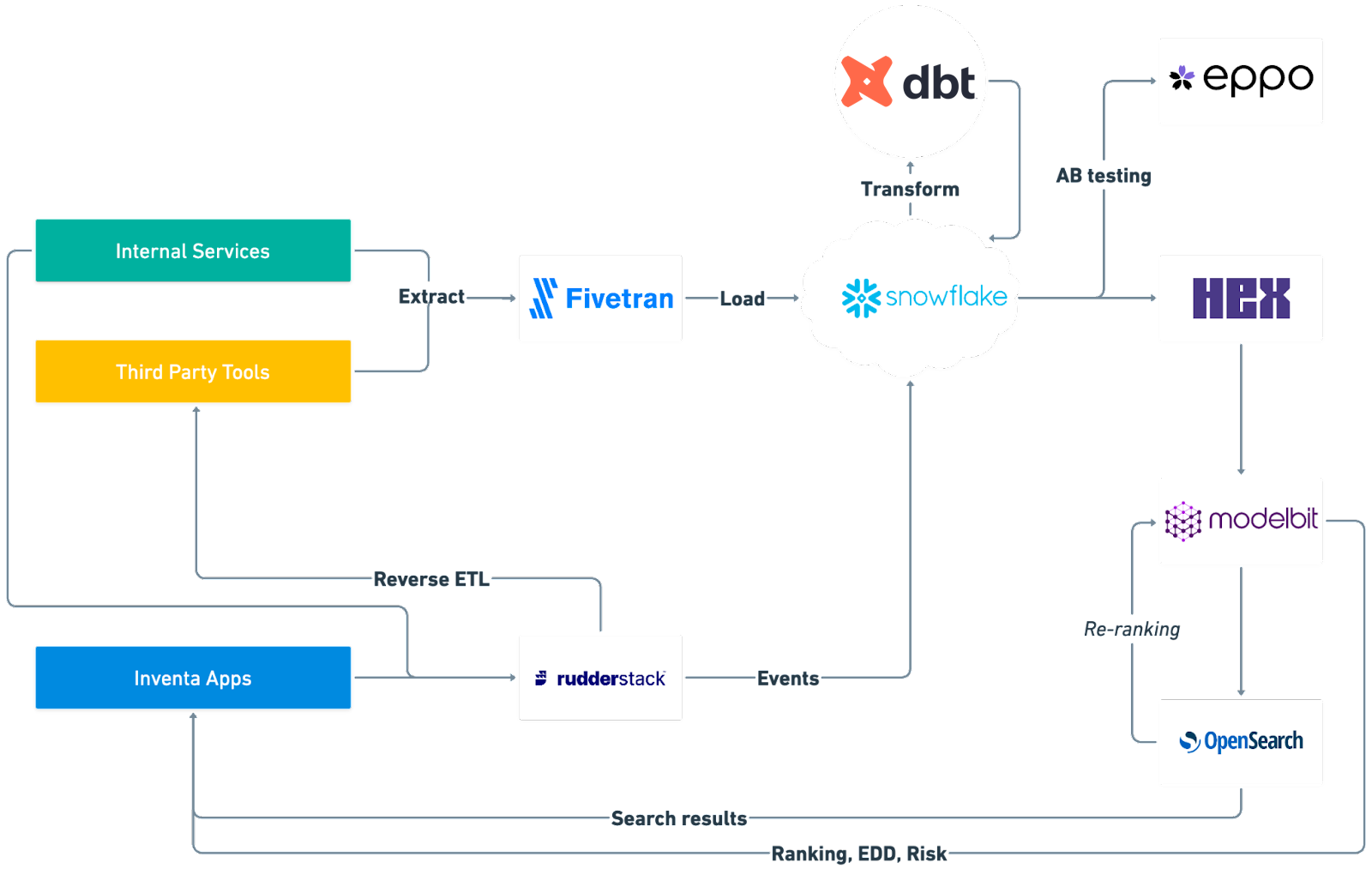A booming business
Based out of Sao Paulo, Brazil, Inventa is one of South America’s fastest-growing prospects. The company functions as a B2B marketplace designed to quickly and efficiently connect countless small businesses with major suppliers, allowing them to stock up on everything from snack foods to cosmetics.
Unlike businesses with similar portfolios operating in North America and Europe, Inventa offers a service tailored to the unique demands of the South American marketplace.
“In Brazil, it's not easy for small businesses to open a credit line,” explained Gabriel Marinho, Lead Analytics Engineer at Inventa. “They also have low leverage with suppliers, so they pay huge shipping fees. They can’t get discounts, and oftentimes the minimum order quantities suppliers require far surpass what small businesses can—or need to—buy.
Many businesses, therefore, don’t use traditional purchasing software. Instead, they work through messaging programs and place orders by directly communicating with sellers—a painful process of bouncing between WhatsApp messages and PDF catalogs. Inventa provides the large market of small businesses and suppliers with a safe, simple platform to complete these transactions.
The need for good data
Connecting a large number of clients and customers means Inventa must handle a lot of information. As the business grew in both reach and ambition, so did its need for reliable data.
“For us, data is almost everything,” said Gabriel. “We want to offer credits to people without a bank history, and it's not easy to extend a credit line without data. So we have our own credit risk model."
This model allows Inventa to evaluate credit applications and help customers improve their access to cash flow, without taking on unwanted risk.”
On the other side, Inveta needs to provide suppliers that sell on their platform with visibility on how their store performs.
“With in-depth reporting, we can help suppliers that are struggling or striving for better results,” shared Gabriel. “Our data assists them in identifying how to improve their products and increase sales.”
An MVP system to start
When Inventa began operations, the company used a Postgres database directly managed by Gabriel.
“At first,” he explained, “we were mainly sourcing free or cheap ways to manage our data. So when I got to the company, my first job was to list the cheapest way we could build a data stack.”
As the information volume Inventa handled started to increase, it quickly became apparent that this low-budget approach would start holding the company back and restrict its ability to grow. The data team spent too much time on maintenance and patching systems together rather than delivering value to the rest of the business.
“I was duct-taping our platform together so it could cope with our growth,” Gabriel said. “This was a problem. Once we received investment funds, we decided we should start fresh—not only for the data team but for the company, too.” Gabriel and his team started evaluating solutions and soon encountered dbt.
“We wanted to use SQL,” he said. “And that's a methodology dbt leads the market for.”
dbt Cloud: Investing in data the right way
After experiencing the difficulties of working with an unstable software stack, Inventa’s data team sought to ensure that their next setup was as reliable and reputable as possible.
“We didn't want to go to a new tool that was not mature enough and would potentially leave us needing to migrate again or change our workflow in the next few years,” Gabriel explained. “We didn't need to cut costs for data infrastructure anymore because we knew data would be the pillar of the business for the next few years of development. It was no longer perceived to be a cost center but rather an investment in the organization's future."
Another of dbt’s major draws was the wealth of information and documentation associated with the solution. With a rapidly growing team, it was crucial to have easy access to resources that detailed best practices and helped the company upskill.
“One of the reasons we went with dbt Cloud was so the rest of the team could try to build machine learning solutions, build better dashboards and BI systems for stakeholders, and create new models themselves,” he explained.

Benefits
Reducing maintenance time and costs
While building and managing their own data stack in Inventa’s early months had its benefits, keeping everything online and running as expected was time-consuming and frustrating. Once the company switched to dbt Cloud, Gabriel and his team freed up a lot of time—time that could be spent developing the business rather than fighting fires.
“Before, maintenance was taking up 80% of my time,” he said. “Now, it's almost 0.”
Gabriel noted that when something fails in dbt, “99% of the time, it's a problem with the source data rather than the system.” Before, it could have been a problem in the pipeline, an accessibility issue, or one of the dozens of other potential errors.
“Finding out the cause,” he added, “used to be a lot of work. A lot of frustrating, time-consuming work.”
With dbt, Inventa’s data pipelines are much easier to understand, assess, and maintain thanks to dbt Cloud's reliability and clear data lineage.
“We now have a huge amount of documentation,” he explained. “With dbt, we can add Git pre-commits hooks and use project evaluator to enforce the CI/CD for documentation.
“I'm setting the guidelines, but I’m also accountable for following them rather than pushing code without documenting it.”
Easy testing
Another significant advantage of moving to dbt Cloud was the ease of testing. Inventa had previously used DynamoDB, which came with its challenges.
“We used to have a lot of bad data,” he explained. “With dbt Cloud, I can easily test the columns that I care about, and when we have an actual problem, we can quickly flag issues to the engineering team.”
With Inventa’s previous data stack, the engineering team's first indication that something went wrong was when the production pipeline broke. Now, the team is alerted the moment a test fails, even if it's not breaking the data pipeline.
“Things are way more robust now,” he said. “This helps the product team avoid any issues reaching customers and helps the data team identify any issues during ingestion.”
Automated reporting to suppliers with the dbt Semantic Layer
The dbt Semantic Layer enables teams to create standardized metrics that return the same consistent and precise data across tools.
Inventa was already using this feature to power their business analytics—it ensured different teams were looking at the same calculation of metrics, such as supply revenue:
“When you put everything on dbt, you ensure everyone is seeing the same number,” said Gabriel. “You don't get that message saying, ‘oh, my director got this GMV number and I'm getting this different one.’”
Supplier analytics—which had shown in customer interviews to be crucial for overall supply and demand performance—was one of their dbt Semantic Layer powered data products.
“We had a lot of MVPs that needed to be worked on and supplier analytics was no exception,” shared Daniel McAuley, Data Lead at Inventa. “It was a manual, error-prone process. We imported a .CSV from a Hex dashboard locally, turned those results into different PDFs, and then uploaded them to Google Drive to send to suppliers."
“It would sometimes take an entire day of work for our business analysts to generate these reports,” winced Daniel.
Once built out, dbt’s Semantic Layer powered all of Inventa’s internal dashboards; next, they saw an opportunity to also use the feature externally:
“We realized the dbt Semantic Layer could take the same metric we used for business analytics and reuse it for supplier reporting,” shared Gabriel.
Inventa used the dbt Semantic Layer to power automated Hex reports for suppliers. Each supplier had a dedicated dashboard, filtered based on their unique supplier ID. The data team could now ditch their former manual process that was taking a full day of work.
“The initial goal was to get this day back. We succeeded, and the feedback from the suppliers has also been really positive,” said Gabriel. “We can now see which suppliers and accounts are looking at the data and have our account managers reach out proactively to help them succeed”.
Distributing ownership through collaboration
One of the less immediately obvious benefits of dbt Cloud was its impact on the broader data team. Inventa’s previous data stack had been too complex for most team members to handle easily, but the relative simplicity of dbt Cloud allowed for much more collaboration—and, with that, ownership.
“Before, I was the only person creating models,” explained Gabriel. “We had five or six data scientists, but they didn't know how to build the pipeline, integrate with Airflow, or deploy a lambda function to AWS directly."
“With dbt Cloud, however, they don't need to know any of that, and they can easily collaborate.”
As the team began collaborating, members adopted best practices on how to model different data, what to discard, and how best to display their insights to end users.
This granted the team ownership over their data, enhanced by their new ability to easily check lineage and documentation with dbt.
“I can now say that I spend only about 1% of my time on maintenance,” Gabriel said, “because I now have 12 people maintaining their own data.”
Company-wide value
Once the new data stack was in place, it didn’t take long for the benefits delivered by dbt to filter out from the data team to the rest of the company.
The seamless integration between dbt Cloud and Inventa’s Hex and Snowflake systems allowed the data team to meet stakeholders where they are.
“The whole company benefits,” Gabriel explained. “A lot more people across the business are using the data because they can see more value. As a result, the whole company has started to do more analysis and be more data-oriented.
“And for hesitating teams, we can say: ‘Look, we have this trusted data set that you can use to test your assumptions and hypotheses. Why don’t you try and use it?' And they can.”
This new approach has helped Inventa to run more efficiently and reliably than ever. Where the data pipeline was once confusing and prone to errors, it’s now viewed as a trustworthy source of valuable insight.
“One thing I used to hear a lot was “can I trust this data?” Gabriel said. “Now they know; if it's there in the warehouse, you can trust it because it's been tested and centralized."
“That is incredibly valuable.”




